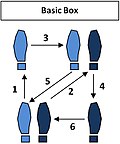There is also a variant, commonly danced in the U.S.A., with box-like basic figures.
Rumba outside Cuba
The ballroom rumba derives its movements and music from the "son", just as do the "salsa" and "mambo".
The Peanut Vendor was the first recording of Cuban music to become an international hit.
It was incorrectly described on the label as a rumba, perhaps because the word "son" would not be understood in English.
The label stuck, and a rumba craze developed through the 1930s.
This kind of rumba was introduced into dance salons in America and Europe in the 1930s, and was characterized by variable tempo, sometimes nearly twice as fast as the modern ballroom rumba.
Early American rumba :
This kind of rumba was introduced into American dance salons at the beginning of the 20th century, characterized by high tempo, nearly twice as fast as the modern ballroom rumba, typical examples being the tunes The Peanut Vendor and Siboney.
Ballroom rumba
International style
- The modern international style of dancing the rumba derives from studies made by dance teacher Monsieur Pierre (Pierre Zurcher-Margolle), who partnered Doris Lavelle. Pierre, then from London, visited Cuba in 1947, 1951 and 1953 to find out how and what Cubans were dancing at that time.
The international ballroom rumba is a slower dance of about 120 beats per minute which corresponds, both in music and in dance to what the Cubans of an older generation called the bolero-son. It is easy to see why, for ease of reference and for marketing, rumba is a better name, however inaccurate; it is the same kind of reason that led later on to the use of salsa as an overall term for popular music of Cuban origin.
No social dances in Cuba involve a hip-sway over the standing leg and, though this is scarcely noticeable in fast salsa, it is more pronounced in the slow ballroom rumba.
In general, steps are kept compact and the dance is danced generally without any rise and fall. This style is authentic, as is the use of free arms in various figures. The basic figures derive from dance moves observed in Havana in the pre-revolutionary period, and have developed their own life since then. Competition figures are often complex, and this is where competition dance separates from social dance.
( Details can be obtained from the syllabuses of dance teaching organizations and from standard texts )

No comments:
Post a Comment